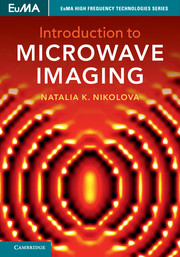Book contents
- Frontmatter
- Dedication
- Epigraph
- Contents
- Preface
- Notation
- Acronyms
- 1 Scalar-Wave Models in Electromagnetic Scattering
- 2 Electromagnetic Scattering: The Vector Model
- 3 Scattering Parameters in Microwave Imaging
- 4 Linear Inversion in Real Space
- 5 Linear Inversion in Fourier Space
- 6 Performance Metrics in Imaging
- 7 Looking Forward: Nonlinear Reconstruction
- Appendix A Maxwell's Equations
- Appendix B Electromagnetic Vector Wave and Helmholtz Equations
- Appendix C Scalarized Electromagnetic Models
- Appendix D Causal, Acausal, and Adjoint Solutions to the Wave Equation
- References
- Index
Preface
Published online by Cambridge University Press: 08 July 2017
- Frontmatter
- Dedication
- Epigraph
- Contents
- Preface
- Notation
- Acronyms
- 1 Scalar-Wave Models in Electromagnetic Scattering
- 2 Electromagnetic Scattering: The Vector Model
- 3 Scattering Parameters in Microwave Imaging
- 4 Linear Inversion in Real Space
- 5 Linear Inversion in Fourier Space
- 6 Performance Metrics in Imaging
- 7 Looking Forward: Nonlinear Reconstruction
- Appendix A Maxwell's Equations
- Appendix B Electromagnetic Vector Wave and Helmholtz Equations
- Appendix C Scalarized Electromagnetic Models
- Appendix D Causal, Acausal, and Adjoint Solutions to the Wave Equation
- References
- Index
Summary
Microwave imaging refers to applications and technology that exploit electromagnetic radiation of frequencies anywhere between several hundred mega-hertz (MHz) and several hundred giga-hertz (GHz). Depending on the frequency, this radiation penetrates many optically opaque media (e.g., fog, foliage, soil, wood, brick, concrete, ceramics, plastics, clothing, etc). It has been used for decades in marine and flight radar, remote sensing, weather radar, reconnaissance and target tracking, and underground surveillance. These applications are referred to as long range, indicating that the distance between the imaged target and the radar system is much greater than any of the following three measures: (i) the target's size, (ii) the size of the antenna or the sensor array, and (iii) the wavelength.
More recently, microwave and millimeter-wave systems have been deployed in a variety of short-range applications where the inspected scene is at a distance comparable to or smaller than at least one of the three measures listed earlier. These include security and surveillance systems for concealed weapon detection and through-the-wall imaging. For instance, the whole body scanners for airplane passenger screening utilize millimeter waves. Microwave systems are also used in nondestructive testing and inspection for structural integrity. The imaging of body parts and tissues has attracted much attention and is the focus of research throughout the world.
Short-range microwave imaging is a vibrant field of research and development that is projected to grow exponentially in the coming years. The main driving force behind this growth is the unprecedented miniaturization of the radio-frequency, microwave, and millimeter-wave technologies. The size and the cost of the hardware needed to perform microwave sensing have dramatically decreased with the advent of the radio-on-a-chip (RoC), the on-chip software-defined radios (SDRs), and the single-chip radars operating well into the 70-GHz bands. Coherent signal measurements with amplitude and phase information are now possible with electronic circuits occupying areas less than a square centimeter and with a price that ranges anywhere between tens and several hundred dollars. Multiplexing hundreds, even thousands, of microwave sensors through digital control is within reach, providing the ability to bypass expensive and bulky RF switching and power-distribution networks. As a result of these advancements, large arrays of microwave sensors are now affordable. Microwave imaging has arrived at a stage of technological development that enables its ubiquitous deployment.
- Type
- Chapter
- Information
- Introduction to Microwave Imaging , pp. xiii - xvPublisher: Cambridge University PressPrint publication year: 2017



